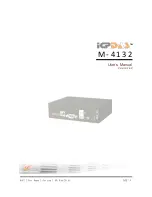
3DQDVRQLF
71
23.2.1.Adaptive Matrix Control Stage
To separate the Centre and Surround signals,
resulting in the minimum amount of cross talk, the
signals are separated by a mathematical processes,
this provides directional enhancement which creates
sharply focused sound images, as well as recreating
directional cues over a wider listening area.
The adaptive matrix is also used to detect dominant
sounds. A dominant sound being simply the sound
that is most prominent in the mix of sounds at any
given instant in time. The highest degree of
dominance occurs when all sounds are placed in one
location. However as this does not occur all the time
we have at the other end of the scale, sounds with
similar intensities which tend to prevent the listener
from being able to pin-point the individual locations,
these sounds needing little or no directional
enhancement. However, while two different sounds
may seem to have the same average loudness, it is
likely that on an instantaneous basis one of them will
be dominant over the other and that the dominance
will continue to alternate between them. Depending
on the peak to average ratios of the sounds over time,
it may or may not be necessary to provide directional
enhancement.
This suggests the decoder must include two
additional characteristics in order to work effectively.
It must be fast enough to provide enhancement on an
instantaneous basis between two or more encoded
positions when the signal peaks are prominent
enough to be heard as individual events, in effect
time-division multiplexing its action among several
individual sounds occurring in rapid succession. Even
though the decoder essentially will be providing
directional enhancement for sounds at only one
position at a time, all of them will be perceived as
separate
from
one
another.
The
second
characteristic is the ability to sense when the relative
dominance falls below the point where it is no longer
necessary for the decoder to provide any substantial
directional enhancement. Since it is the relative level
of one sound to another which determines the
perception of separation it is desirable to have
sensing circuits that ignore absolute signal level in
favour of being responsive to the difference in level
between two signals, the equivalent of taking their
ratio. Electrically, this is no simple task, but by taking
the logarithm of each signal and subtracting one from
the other, it is possible obtain a measure of relative
dominance.
Knowing which signal is dominant also includes
knowing the encoded position, or angle, of the signal.
It is in this direction that enhancement must take
place, and may encompass any point in a 360
E
circle,
not just one of the four cardinal positions
For these reasons Pro
.
Logic has been designed to
sense the level of dominance in the sound-track.
23.2.2.Surround channel Processing.
Surround channel processing for the passive and
active decoders once again use identical signal
processing methods.
After the matrix stage, the surround signal undergoes
four further steps :
1.
Anti Alias Filter
This filter is used to prevent spurious beat
products occurring as a result of the sampling
process in the time delay stage, due to the wide
range of sampling frequencies employed by
the delay line stage. The filter is also used to
prevent picture-related radiation from
interfering with the audio signals when
surround decoders are used in television
receivers.
2.
Time delay
The time delay stage is used to delay the arrival
time of the surround sound to the listener. This
is used to improve stereo separation between
the front and rear speakers, this takes
advantage of the "Haas" or precedence effect
which helps reduce the perception of leakage
signals from surround speakers. In order to do
this, the decoder must compensate for the
travel time of sound through the air, which is
approximately one foot per millisecond. By
knowing the distance from the listening
position to the front and surround speakers, it
is then possible to adjust the time delay to
obtain the desired results.
3.
Frequency bandlimiting to 7kHz
This Low Pass Filter is used as the original
surround signal was bandlimited to 7kHz
during encoding. The filter improves processor
tracking by preventing high frequency audio
signals from entering the decoder.
4.
Modified Dolby B-type noise reduction.
This final stage in the surround chain restores
the signal to its original spectrum while
reducing noise and certain cross-talk signals
The surround signal then rejoins the front channel
signals in the master level control which adjusts the
overall listening volume without disturbing channel
balance.
Here the signals are output via individual level trim
stages which are used to enable the user to match
speaker levels for proper system balance.
Summary of Contents for EURO 4 Chassis
Page 24: ...3DQDVRQLF 24 ...
Page 26: ...3DQDVRQLF 26 TV STANDARDS ...
Page 93: ...3DQDVRQLF 10 ...
Page 97: ...3DQDVRQLF 14 Chapter 2 EURO 4 Supplement P Board DAF Circuit ...
Page 101: ...3DQDVRQLF 18 ...
Page 121: ...3DQDVRQLF 38 Chapter 3 EURO 4H Supplement Y Board Schematic ...
Page 124: ...3DQDVRQLF 41 ...
















































